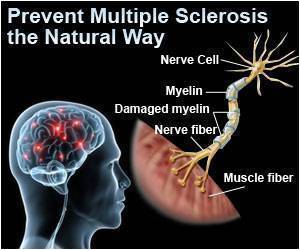Nanoparticles attached to myelin sheath may help patients of multiple sclerosis, according to researchers.
The nanoparticles are made up of FDA-approved substance, a polymer called Poly (lactide-co-glycolide) (PLG), comprising of glycolic acid and lactic acid, both being the natural metabolites of the human body.Nanoparticles of different sizes were tested by the researchers and it was realized that 500 nanometers was ideal for modulating the immune reaction.
In multiple sclerosis, the myelin sheath is attacked by immune system, thus damaging the lining of the nerve cells in spinal cord, brain, and optic nerves.
When the insulation is destroyed, the transmission of electrical signals is hampered. This interference leads to symptoms ranging from limb numbness to blindness or even paralysis.
The disease relapses in around 80 percent of patients with multiple sclerosis.
According to the researchers, unlike current therapies for multiple sclerosis, nanoparticles do not inhibit the whole immune system; therefore, the patients are not exposed to everyday’s infections.
Following injection, the nanoparticles were filtered in the spleen..
Stephen Miller stated, “This is a highly significant breakthrough in translational immunotherapy.” He added, “The beauty of this new technology is it can be used in many immune-related diseases. We simply change the antigen that’s delivered.”
Professor Miller said, “The holy grail is to develop a therapy that is specific to the pathological immune response, in this case the body attacking myelin.”
The scientists said that their approach returned the immune system back to normalcy and it did not attack the myelin sheath. Therefore, the functioning of immune system remains intact.
Lonnie Shea, the Professor of Chemical and Biological Engineering at Northwestern’s McCormick School of Engineering and Applied Science, invented these nanoparticles.
Professor Miller mentioned, “We administered these particles to animals who have a disease very similar to relapsing remitting multiple sclerosis and stopped it in its tracks.”
“We prevented any future relapses for up to 100 days, which is the equivalent of several years in the life of an MS patient.”
The scientists are evaluating the effectiveness of nanoparticles in treating respiratory airway diseases and type 1 diabetes
Christine Kelley, the Director of the National Institute of Biomedical Imaging and Bioengineering division of Discovery Science and Technology at the National Institutes of Health, which supported the research, was of the opinion, “The key here is that this antigen/particle-based approach to induction of tolerance is selective and targeted. Unlike generalized immunosuppression, which is the current therapy used for autoimmune diseases, this new process does not shut down the whole immune system.”
The researchers concluded that their study was successful in ensuring the importance of technologies in simplifying the treatment for the patients with multiple sclerosis and other autoimmune ailments.
The research was financially supported by the Myelin Repair Foundation and National Institute of Biomedical Imaging and Bioengineering of the National Institutes of Health and Juvenile Diabetes Research Foundation.
References:
1. Nanoparticle shows promise in treatment of multiple sclerosis. Gizmag
2. New nanoparticle halts multiple sclerosis, now being tested in Type… Phys.
Source-Medindia














